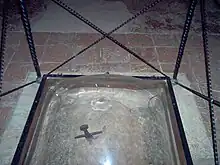Saint Galgano Guidotti | |
|---|---|
 15th-century portrait by Giovanni d'Ambrogio | |
| Born | 1148 Chiusdino, Siena, Italy |
| Died | 1181 Montesiepi, Tuscany, Italy |
| Venerated in | Roman Catholic Church |
| Canonized | 1185 by Pope Lucius III |
| Feast | 30 November |
Galgano Guidotti (1148 – 3 December 1181)[lower-alpha 1] was a Catholic saint from Tuscany born in Chiusdino, in the modern province of Siena, Italy. His mother's name was Dionigia, while his father's name (Guido or Guidotto) only appeared in a document dated in the 16th century, when the last name Guidotti was attributed.
The canonization process to declare Galgano a saint started in 1185, only a few years after his death, and his canonization was the first conducted with a formal process by the Roman Church.[1] A lot of Galgano's life is known through the documents of the canonization process in 1185[2] and other Vitae: Legenda beati Galgani[3] by anonymous, Legenda beati Galgani confessoris by an unknown Cistercian monk,[4] Leggenda di Sancto Galgano,[5] Vita sancti Galgani de Senis,[6] Vita beati Galgani.[7]
Biography
The son of a feudal lord, Galgano became a knight, and is said to have led a ruthless life in his early years.[8]
Galgano died in 1181. Soon after, in 1184, a round chapel was built over his claimed tomb to commemorate him;[9] pilgrims came there in large numbers, and miracles were claimed. In that year, Cistercian monks took over Montesiepi at the request of Hugh, bishop of Volterra, but most of Galgano's monks left, scattered over Tuscany, and became Augustinian hermits. By 1220, San Galgano Abbey, a large Cistercian monastery, had been built below Galgano's hermitage: he was then claimed and recognized as a Cistercian saint. His cult was lively in Siena and Volterra, where numerous representations survive. The ruins of his hermitage can still be seen, while his cloak is kept in the church of Santuccio at Siena.[10]
The sword in the stone

The sword in the stone can be seen at the Rotonda at Montesiepi, near the ruins of the Abbey of San Galgano. The handle of a sword protrudes from a stone, and is said to be the sword of Galgano. An analysis of the metal done in 2001[11] by Luigi Garlaschelli confirmed that the "composition of the metal and the style are compatible with the era of the legend". The analysis also confirmed that the upper piece and the invisible lower one are authentic and belong to one and the same artifact.[12]
In the media
Television
Galgano's "sword in the stone" story was featured in a season 7 episode of TV series, Forged in Fire. Bladesmiths had to recreate "Excalibur", a medieval broadsword possibly inspired by Galgano's story.[13] The episode explained the story as follows: the actual Sword in the Stone is located in Siena, Italy, and believed to have belonged to Galgano.
An episode of Ancient X-files looked at the sword in the stone and the connections between it, and St Galgano, to Sir Gawain and King Arthur. It included some scientific exploration of the stone. [14]
See also
References
Footnotes
- ↑ His alleged date of death is 3 December 1181, but other scholars assign it to 30 November 1180. The Roman Catholic Church celebrates Saint Galgano on 30 November, as ordered in 2004 by Pope John Paul II.
Citations
- ↑ As reported by A. Vauchez in "La santità nel medioevo", Il Mulino, Bologna, 1989
- ↑ Inquisitio in partibus, transcribed by Sigismondo Tizio in Historiae Senenses and transcribed in "Analecta Toscana IV; Der Einsiedler Galgano von chiusino und die Anfange von San Galgano" by Fedor Schneider (1914–1924).
- ↑ Codice Laurenziano, 14th century
- ↑ Codice di Siena, 15th century
- ↑ Biblioteca Apostolica Vaticana, cod. Chigi M. V. 118, 15th century.
- ↑ Codice di Veroli, 15th century.
- ↑ Codice Laurenziano, 15th century.
- ↑ Rory Carroll, Tuscany's Excalibur is the real thing, say scientists, The Guardian, 16 September 2001, accessed 25 April 2021
- ↑ Haegen, Anne Mueller von der; Strasser, Ruth F. (2013). "Chiusdino". Art & Architecture: Tuscany. Potsdam: H.F.Ullmann Publishing. p. 424. ISBN 978-3-8480-0321-1.
- ↑ “Galgano” in David Hugh Farmer, Oxford Dictionary of Saints (Oxford University Press, 1997)
- ↑ Carroll, Rory (16 September 2001). "Tuscany's Excalibur is the real thing, say scientists". the Guardian. Retrieved 3 November 2018.
- ↑ Chodyński, Antoni Romuald (2014). Fasciculi Archaeologiae Historicae. Fasc. 27 (2014). Institute of Archaeology and Ethnology of Polish Academy of Sciences.
- ↑ "Watch The Sword in the Stone Full Episode - Forged in Fire". HISTORY. Retrieved 12 March 2021.
- ↑ "Ancient X-File v The Sword In The Stone".
External links
- The Life of Saint Galgano on Audiobook by Alleluia Audiobooks (on mp3)
- What to do in and around San Galgano Abbey (with Google Map)
- website with information about San Galgano Abbey
- Discovering San-Galganos Abbey
- San-Galgano and the sword in the stone; King Arthur in Tuscany
- Very informative website about the Abbey of San Galgano, history, pictures, info, map, accommodation and lots more